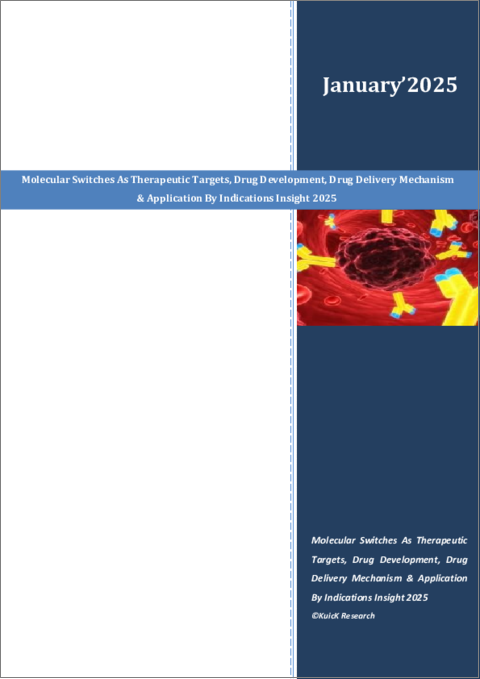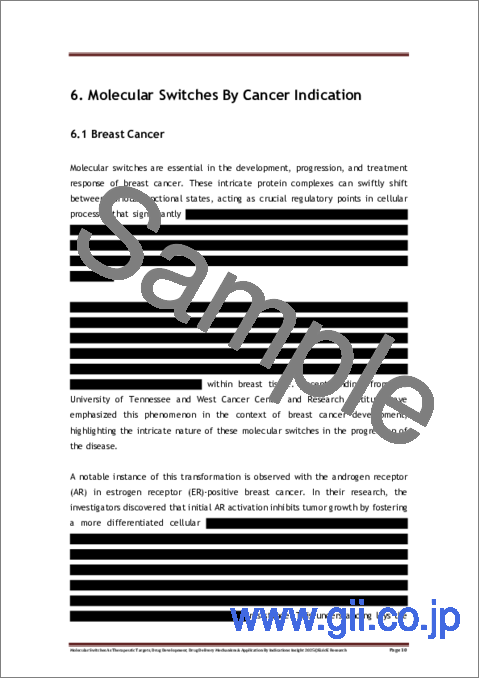|
|
市場調査レポート
商品コード
1627538
分子スイッチ市場:治療標的、医薬品開発、ドラッグデリバリーメカニズム、適応症別用途:2025年Molecular Switches As Therapeutic Targets, Drug Development, Drug Delivery Mechanism & Application By Indications Insight 2025 |
||||||
|
|||||||
| 分子スイッチ市場:治療標的、医薬品開発、ドラッグデリバリーメカニズム、適応症別用途:2025年 |
|
出版日: 2025年01月01日
発行: KuicK Research
ページ情報: 英文 150 Pages
納期: 即日から翌営業日
|
全表示
- 概要
- 図表
- 目次
分子スイッチは、特定の環境的あるいは生物学的トリガーに反応して、異なる状態間を移行することができる動的な存在です。これらのトリガーには、pHの変化、光照射、温度、酸化還元条件、特定のイオンや生体分子の存在などが含まれます。分子スイッチングの概念は、高度に制御された診断・治療システムの基盤を提供することで、医療・製薬分野に大きな影響を与えてきました。生物学的反応を正確に制御する能力により、分子スイッチは高度なドラッグデリバリーシステム、リアルタイム診断ツール、個別化治療介入の開発に不可欠なものとなっています。
医薬品分野では、分子スイッチは、医薬品有効成分の放出を時空間的に正確に制御することを可能にし、ドラッグデリバリーに革命をもたらしました。pH感受性の分子スイッチは、ナノ粒子ベースの薬物キャリアに採用されており、通常の生理的条件下では安定性を保ちますが、酸性環境では分解してペイロードを放出します。例えば、FPBC@SNナノ粒子システムは、乳がん細胞の酸性細胞質を標的とするpH感受性分子スイッチを統合しています。このシステムは、フェロプターシスを誘導するソラフェニブと、腫瘍免疫を増強するIDO阻害剤の両方を放出します。このようなスイッチを活用することで、これらのシステムはオフターゲット効果を減らし、治療指数を高め、腫瘍学における重要な課題に対処します。
当レポートは、世界の分子スイッチ市場について調査し、市場の概要とともに、分子スイッチの治療標的としての重要性、セグメント別動向、新興技術と今後の見通しなどを提供しています。
目次
第1章 分子スイッチのイントロダクション
第2章 分子スイッチの医学的意義
第3章 ドラッグデリバリーと放出における分子スイッチの重要性
- 概要
- 進行中の研究開発
第4章 分子スイッチの治療標的としての重要性
第5章 分子スイッチ- 大分類
第6章 分子スイッチ、がん適応別
- 乳がん
- 前立腺がん
- 大腸がん
- 肺がん
- 胃がん
第7章 分子スイッチ、神経疾患別
- パーキンソン病
- アルツハイマー病
- 多発性硬化症
第8章 分子スイッチ、感染症別
- ウイルス感染
- 細菌感染
第9章 分子スイッチ、自己免疫疾患と炎症性疾患別
- 糖尿病
- 関節炎
- ループス
- 乾癬
第10章 分子スイッチ、心血管疾患別
- 心筋梗塞(心臓発作)
- その他
第11章 再生医療における分子スイッチの重要性
第12章 分子スイッチを標的とした主要医薬品の販売動向
第13章 医薬品処方における分子スイッチ
- スマートな医薬品処方と分子スイッチ
- 生体材料ベースのドラッグデリバリーシステム
- 自己規制薬物システム
第14章 現在の動向と新興技術
- ナノ医療における分子スイッチ
- 応答性薬物システムの革新
- 人工知能と機械学習との統合
第15章 将来の展望と方向性
- 分子スイッチ技術の進歩
- 分子スイッチによる個別化医療の未来
- 創薬と治療への潜在的影響
List of Figures
- Figure 1-1: Molecular Switches - Introduction
- Figure 1-2: Molecular Switches - Emergence & Evolution
- Figure 3-1: Molecular Switches In Drug Delivery & Release
- Figure 3-2: Drug Delivery Systems With Molecular Switches
- Figure 3-3: Peptide-Based Drug Delivery System
- Figure 3-4: Switchable Molecular Tweezers
- Figure 3-5: Rotaxane-Based Drug Delivery System
- Figure 3-6: Enzyme-Activatable Drug Delivery System
- Figure 3-7: Light-Responsive Drug Delivery Systems
- Figure 3-8: Photo-Responsive Drug Delivery Using Spiropyran
- Figure 3-9: Photopharmacological Approach For Neuropathic Pain
- Figure 3-10: Insulin Prodrug Activation
- Figure 6-1: AR Activation & Its Dual Role In Tumor Growth
- Figure 6-2: PRL-3 Activation & AMPI-109's Impact On TNBC
- Figure 6-3: Molecular Switch in Prostate Cancer
- Figure 7-1: PINK1-Parkin Molecular Switch In Parkinson's Disease
- Figure 8-1: Molecular Switches In Viral infections
Figure 11 1: Molecular Switches In Regenerative Medicine
- Figure 13-1: Smart Drug Delivery With Molecular Switches
- Figure 13-2: Biomaterial Based Drug Delivery Systems With Molecular Switches
- Figure 13-3: Self-regulating Drug Systems With Molecular Switches
- Figure 14-1: Molecular Switches In Nanomedicine
- Figure 14-2: Molecular switches In Responsive Drug Systems
- Figure 14-3: Integration Of Molecular Switches With Artificial Intelligence & Machine Learning
List of Tables
- Table 1-1: Traditional v/s Molecular Switch Enabled Drug Delivery
- Table 4-1: Examples Of Approved Drugs Targeting Molecular Switches
- Table 5-1: Molecular Switches - Broad Classification
- Table 12-1: Top 20 Drugs Targeting Molecular Switches (US$ Billion), 2022-2024
Molecular Switches As Therapeutic Targets, Drug Development, Drug Delivery Mechanism & Application By Indications Insight 2025 Research Insights:
- Top 20 Drugs Sales Targeting Molecular Switches: 2022 - 2024
- Molecular Switches Significance In Regenerative Medicine & Nanomedicine
- Molecular Switches Significance In Drug Delivery & Release
- Molecular Switches Significance As Therapeutic Targets
- Molecular Switches In Cancer Therapeutics: Breast Cancer, Prostate Cancer, Lung Cancer, Colorectal Cancer, Gastric Cancer
- Molecular Switches In Neurological Disorder: Parkinson's Disease, Alzheimer's Disease, Multiple Sclerosis
- Molecular Switches In Autoimmune & Inflammatory Disorder: Diabetes, Arthritis, Lupus, Psoriasis
Molecular switches are dynamic entities capable of transitioning between distinct states in response to specific environmental or biological triggers. These triggers can include changes in pH, light exposure, temperature, redox conditions, or the presence of certain ions or biomolecules. The concept of molecular switching has significantly influenced the medical and pharmaceutical domain by providing a foundation for highly controlled diagnostic and therapeutic systems. The ability to precisely regulate biological responses has made molecular switches indispensable in the development of advanced drug delivery systems, real-time diagnostic tools, and personalized therapeutic interventions.
In the pharmaceutical sector, molecular switches have revolutionized drug delivery by enabling precise spatiotemporal control over the release of active pharmaceutical ingredients. One of the most widely explored triggers is pH, as pathological conditions like cancer and inflammation often create acidic microenvironments. pH-sensitive molecular switches are employed in nanoparticle-based drug carriers, which remain stable under normal physiological conditions but disassemble in acidic environments to release their payload. For example, the FPBC@SN nanoparticle system integrates a pH-sensitive molecular switch to target acidic cytoplasm in breast cancer cells. This system releases both sorafenib, which induces ferroptosis, and an IDO inhibitor to enhance tumor immunity. By leveraging such switches, these systems reduce off-target effects and enhance the therapeutic index, addressing key challenges in oncology.
Table of Contents
1. Introduction To Molecular Switches
- 1.1 Overview
- 1.2 History & Emergence In Medicine
2. Molecular Switches Clinical Significance In Medicine
3. Molecular Switches Significance In Drug Delivery & Release
- 3.1 Overview
- 3.2 Ongoing Research & Developments
4. Molecular Switches Significance As Therapeutic Targets
5. Molecular Switches - Broad Classification
6. Molecular Switches By Cancer Indication
- 6.1 Breast Cancer
- 6.2 Prostate Cancer
- 6.3 Colorectal cancer
- 6.4 Lung Cancer
- 6.5 Gastric Cancer
7. Molecular Switches By Neurological Disorder
- 7.1 Parkinson's Disease
- 7.2 Alzheimer's Disease
- 7.3 Multiple Sclerosis
8. Molecular Switches By Infectious Disease
- 8.1 Viral Infection
- 8.2 Bacterial Infection
9. Molecular Switches By Autoimmune & Inflammatory Disorder
- 9.1 Diabetes
- 9.2 Arthritis
- 9.3 Lupus
- 9.4 Psoriasis
10. Molecular Switches By Cardiovascular Disease
- 10.1 Myocardial Infarction (Heart Attack)
- 10.2 Others
11. Molecular Switches Significance In Regenerative Medicine
12. Sales Insight Of Key Drugs Targeting Molecular Switches
13. Molecular Switches In Drug Formulation
- 13.1 Smart Drug Formulations & Molecular Switches
- 13.2 Biomaterial Based Drug Delivery Systems
- 13.3 Self Regulating Drug Systems
14. Current Trends & Emerging Technologies
- 14.1 Molecular Switches In Nanomedicine
- 14.2 Innovations In Responsive Drug Systems
- 14.3 Integration With Artificial Intelligence & Machine Learning
15. Future Perspectives & Directions
- 15.1 Advancements In Molecular Switch Technology
- 15.2 The Future Of Personalized Medicine With Molecular Switches
- 15.3 Potential Impact On Drug Discovery & Therapeutics





